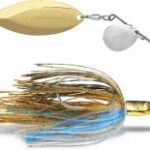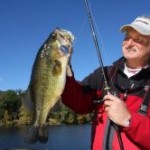Spin Up Some Fall Bass Fast in Northern Lakes
Spinnerbait secrets for late-season success
By Dan Johnson
from The Fishing Wire
Duck hunters’ jonboats may outnumber bass boats on many lakes in mid to late fall, but that doesn’t mean there isn’t fine fishing to be found. Both largemouths and smallmouths offer great opportunities for bass fans faithful enough to pursue their favorite fish deep into autumn.
One of the most effective and easiest to fish patterns hinges on the simple but deadly spinnerbait. Just ask bassin’ ace Scott Bonnema, who slings blades for burly bass virtually until first ice ushers in the hard-water season. “From the time water temperatures hit the low to upper 50-degree range, right through ice-up, is some of the best fishing of the year on North-country lakes,” he says.
While shoreline reed beds, docks and other skinny water cover and structure may be tempting targets, the action actually heats up farther from the bank, in depths of 12 to 14 feet or more, depending on the lake. “As shallow weed growth dies off, bass slide out into deeper vegetation that’s still green and healthy, such as clumps of coontail and cabbage,” he explains.
Structurally speaking, one of his favorite finds is a weed-crowned underwater hump, although points, inside turns and other irregularities have potential as well. Access to deeper water is a plus, but bass have no problem wintering on flats in the 20-foot range, so don’t limit your search to areas adjacent to extreme depths.
To find fish fast, Bonnema idles his boat over likely lies, keenly eyeing the split-screen display on his Humminbird 1198c electronics. As GPS mapping guides him along key contours and across prime flats, sonar returns-both in traditional and picture-like Down Imaging mode-highlight promising weed patches and fish lurking in or near the greenery.
Make long casts and allow the bait to settle on bottom before beginning your retrieve.On the presentational front, he favors hefty spinnerbaits in the ¾- to 1½-ounce class for their ability to cover deep water in search of fish, as well as trigger strikes. One of his favorite designs is Terminator’s T-1 Original Titanium Spinnerbait. It stands up to abuse from bass and bonus northern pike, and has beveled blades and an easy-to-swap, QuickChange silicone skirt.
“Experiment with skirt color, along with blade finish and style, to find what the fish prefer,” he says. “I typically start with a white skirt and chrome, double willow-leaf blades for largemouths. Smallmouths love chartreuse, so adding a touch of that to the pattern can make a big difference.”
Colors that mimic baitfish are also hot. “For the most part, bass are feeding on young of the year sunfish-we call them bass potato chips-as well as various minnows and juvenile yellow perch,” he adds. “So darker colors, along with golds and blues, have their place, too.”
A variety of middleweight spinning and casting tackle works for this tactic. Bonnema prefers a medium to medium-heavy, 7-foot Lew’s Tournament Speed Stick, which offers ample length for long casts, and plenty of backbone for solid hooksets. A tractor-geared casting reel like the 5.1:1 model in Lew’s BB1 Pro Speed Spool lineup is a plus for pulling big baits slowly along bottom. He typically spools up with 14-pound Sufix Castable Invisiline fluorocarbon, but bumps up to 17-pound test in dirty water.
After firing out a cast, Bonnema lets the spinnerbait settle. “One of the most common mistakes I see people make this time of year is to throw way out there and instantly start to reel it in,” he says. “It’s important to let it hit bottom.” When the bait lands, he tightens the line and gives it a sharp snap to start the blades spinning.
The ensuing retrieve is unhurried and relatively inanimate. “It’s natural to want to fish fast and cover water, but you need to keep the bait moving slow and steady over the weed clumps-not making the bass chase it too hard,” he says. “When you tick grass, snap the spinnerbait out and let it flutter back down.”
Slowly ticking a spinnerbait across deep weed clumps is key to consistent catches once bass abandon shoreline cover.
Getting the first strike is often key to a flurry of action. “Bass are a little more lethargic right now, but once you trigger one, the rest of the group gets excited and you can usually catch a few more from the same area,” he says. “In fact, anytime you catch a fish, mark the spot with a waypoint or marker buoy, or make a good mental note of the location, and target it with multiple casts.”
Bonnema believes time of day is also a factor in the pattern. “The morning bite is good, but you don’t need to be out at first light like earlier in the season,” he says. “As the day warms, the fish move higher in the weeds, and you can be a little more aggressive with your presentation.”
One word of caution is in order for northern anglers, however. When fall turnover occurs, it can shut down the fishing in a hurry. “It’s like flipping a switch,” says Bonnema. “You know right away what happened. Weeds and bottom debris are floating everywhere, the water looks dingy, and the bass aren’t biting.”
When turnover strikes, he suggests switching to a lake that’s not undergoing this annual process, or waiting at least a week to fish the affected lake again.
In the end, the deep game can be intimidating to anglers accustomed to flipping and pitching close to shore, but it’s a simple and stellar tactic for tapping the fine fall fishing overlooked by all but a few die-hard bass fans.

